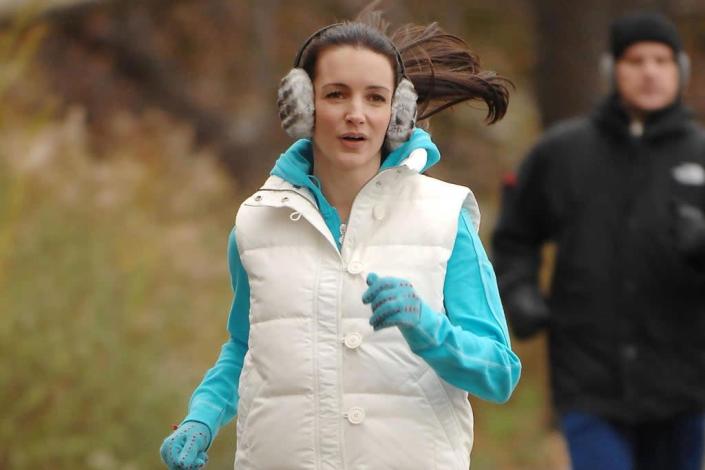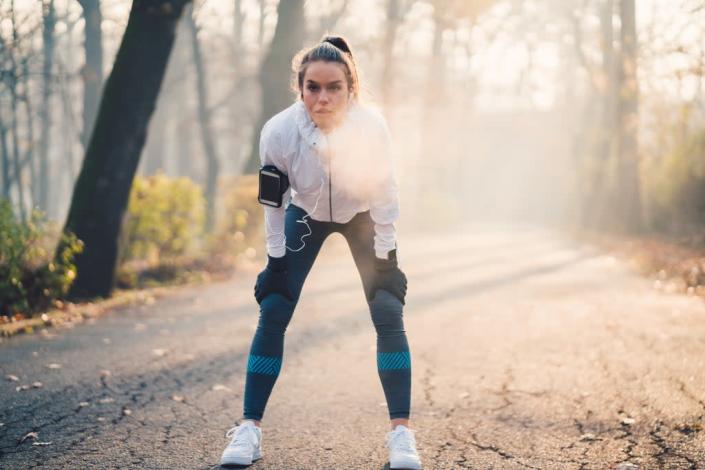
In the colder months, those who run regularly may feel deterred from going on their usual outdoor jogs.
But exercising outside during the chillier part of the year can be extremely beneficial for your wellbeing, providing you with an effective cardiovascular workout and a rush of endorphins.
When planning for a run during winter, it’s essential that you take certain precautions in order to ensure that you don’t put yourself in harm’s way.
Warming up before exercise is always important, but even more so when your muscles are at risk of becoming especially tight in low temperatures.
Furthermore, you may need to invest in reflective clothing if running during the early or late hours so that drivers on the road are aware of your whereabouts.
The Independent spoke to several experts for their top tips on running during winter. Here’s everything you need to know:
Dress for the occasion
One of the key items you should have in your workout wardrobe when preparing for outdoor winter exercise is a waterproof jacket, explains realbuzz running expert and former Great Britain competitor Louise Damen.
Not only will a waterproof jacket keep you dry if you get caught in the rain, but it’ll also provide you with insulation in all sorts of weather conditions.
Damen additionally suggests buying clothes such as tights or arm warmers in order to keep your body temperature at a sufficient level during runs.
“As the temperature begins to drop, it’s imperative to keep your muscles warm if you want them to work optimally,” she says.
“The most effective way to trap heat and to stay warm whilst facing the winter elements is to layer up. A base layer should draw moisture away from your skin to prevent you from feeling the chill.
“Compression type tops make ideal base layers as they are lightweight and fit snuggly.”
Damen advises wearing a hat to keep your head and ears nice and toasty.
Check the weather forecast
Before you go on your run, it may be worth checking the weather forecast to see if any gusts of wind may be coming your way.
If so, then you can plan your run accordingly in order to make the wind work in your favour.

“A nice tip on windy days is to start your run into the wind so it’s behind you on the way home,” says Luke Worthington, human movement and elite performance specialist.
Worthington also advises facing oncoming traffic if running on narrow roads or country lanes so that drivers will see you as they approach.
Make warming up a priority
Warming up before exercise is always important, as it helps to increase your body temperature and blood flow to your muscles.
As the temperature drops outside, warming up before a run is even more vital, as your muscles will likely be more prone to tightening up.
“Colder climates can cause tighter muscles, as there is less heat in your body,” explains Abbas Kanani, a pharmacist at Chemist Click.
“You should prepare your body before rigorous exercises by performing a warm up, to avoid muscle and tissue soreness.
“This allows for an increase in blood flow to the muscles, making them more flexible and able to perform broader ranges of motion without putting an extra stress on them.”
Furthermore, warming up will deliver more oxygen to your muscles, which will allow them to work as hard as possible during exercise.
Regulate your breathing
When heading out on a run during the colder months, you may find it harder to breathe than usual.
There are simple tactics that you can try to regulate your breathing, as Andy McGhee, founder of Pinnacle Performance and partner at Kymira Sport explains.
“Learning to breathe while running will go a long way,” he says.
“To help control breathing start with a ‘three in and three out’ breathing rate. This simply means taking a breath every three steps, before exhaling for another three steps.
“It might also help to develop your rhythm with this and running apps or a metronome can help with this.”
Keep hydrating
When doing any form of exercise, whether it’s indoors, outdoors, during summer or during winter, staying hydrated is always paramount.
“Don’t forget to still hydrate. It’s an obvious one in the summer, but you still lose fluid through sweating and also breathing even in the colder months,” Worthington says.
“So don’t forget to replace the fluid even if you don’t feel thirsty.”
Team up with friends
Motivating yourself to exercise during winter can be a difficult task, especially if it requires waking up at ungodly hours.
In order to tackle this, you could team up with some friends and go on group runs together, spurring each other on along the way.

“As with any kind of training, it’s always more enjoyable if there is someone else to train with,” Damen says.
“If this means getting yourself along to a club and meeting up with other runners, then you should do this.
“Not only is this great for your motivation and commitment levels, there is also the added safety bonus of not running alone.”
Stay safe
If you choose to go for a run in the early morning or evening during winter, then there’s a strong chance that there’s not going to be a great amount of sunlight.
Therefore, you must make sure that you prioritise your safety when there’s a lack of visibility outside, especially if you’re going to be crossing or running along roads.
“As the dark evenings set in, it is definitely worth investing in some high-vis kit so that you can be seen by drivers and other road users,” Damen advises.
“However, if you’re not keen on bright colours you don’t have to dress as if you are going to a neon rave – a lot of technical winter kit now includes reflective panels and prints.”
Damen also suggests investing in a head torch if there’s limited street lighting along your road or uneven surfaces that could be a safety hazard.
[This article was originally published in 2019]





